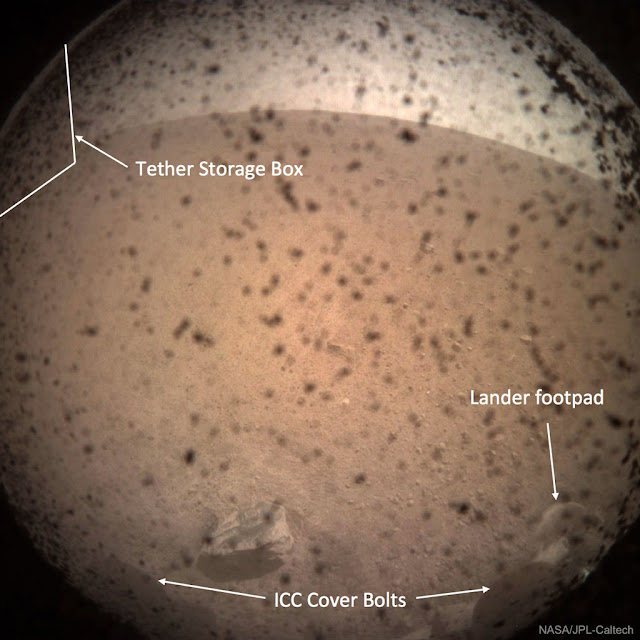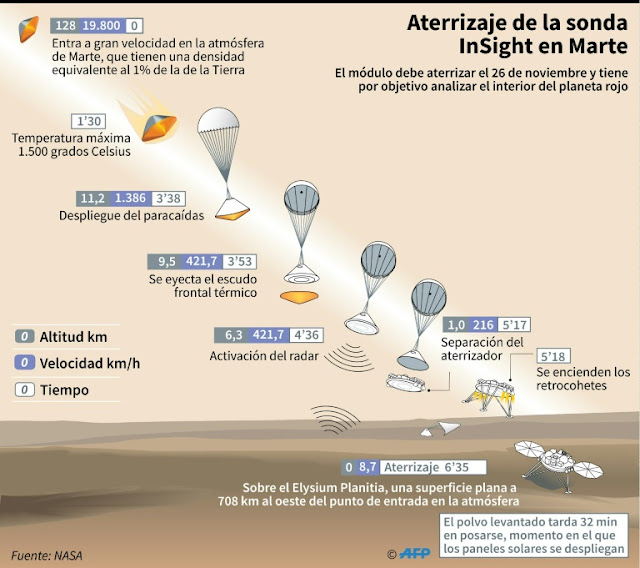I like astronomy, archaeology, photography, music and drinking a lot of tea. I hate politics. Something that annoys me: that I shall not respect the permanence, and to take me by what I'm not. The best sign: VIRGO. The worst: the health. The best: adapt and know how to get ahead. FIRST BLOG: esplaobs.blogspot.com, SECOND BLOG: esplaobs02.blogspot.com, RETRO BLOG: esplaobs01.blogspot.com, YOUTUBE CHANNELS: esplaobs, esplaobs. ext02. Instagram: esplaobsrosario. Welcome to my BLOGs !
Friday, November 30, 2018
A COLD RIVER TO ORION Image Credit & Copyright: Juris Sennikovs
Ice is forming on the river Lielupe as it flows through the landscape in this winter's night scene. Even in motion the frigid water still reflects a starry sky, though. The well planned, Orion-centered panorama looks toward the south, taken in three exposures from a bridge near the village of Stalgene, Latvia, planet Earth. Drifting pancakes of ice leave streaks in the long exposures, while familiar stars of Orion and the northern winter night appear above and below the horizon. Village lights along the horizon include skyward beams from the local community church. This image was a first place winner in the 2018 StarSpace astrophotography competition.
Thursday, November 29, 2018
COMETA 46P/WIRTANEN DESDE ROSARIO - ARGENTINA /// FOTOS: ESMERALDA SOSA - INFO: LICENCIADO EN FÍSICA JOSÉ LUIS LOMÁSCOLO
.. de 8pm a 10pm ..
.. bastante nublado ..
... RECOMIENDO UNA LUPA Y UN TELESCOPIO DEL TAMAÑO DEL HUBBLE ! ...
La mancha vaporosa que se puede observar al lado de la estrella TYC 5862-343-1 de magnitud aparente 10.476 y cuyas coordenadas son Ascensión recta 2h 28m 11.61s, Declinación -22° 14' 33.5" perteneciente a la constelación de la Ballena,es la coma o cabellera del cometa 46P Wirtanen.
El color verde que se observa según algunos es debido a la presencia de Cianuro de Hidrógeno en la cabellera pero este emite en el violeta / azul, es más probable que dicho color sea generado por el Carbono diatómico cuyo pico de emisión se encuentra en los 510 nanómetros, correspondiente a la región del verde dentro del espectro visible.
Info: Licenciado en Física José Luis Lomáscolo
PARA VER FOTOS EN HD ABRIR SIGUIENTE LINK
( y SUGIERO VERLAS SI O SI EN HD - ES MUY TENUE EL COMETA )
Wednesday, November 28, 2018
COMET 46P WIRTANEN Taken by Gerald Rhemann on November 26, 2018 @ Farm Tivoli, Namibia, SW - Africa
Telescope: ASA Astrograph 12f3.6
Camera: FLI ML 16200
Mount: ASA DDM85
Exposure time: LRGB 30/15/15/15 min.
IC 1871: INSIDE THE SOUL NEBULA Image Credit & Copyright: Mark Hanson
This cosmic close-up looks deep inside the Soul Nebula. The dark and brooding dust clouds on the left, outlined by bright ridges of glowing gas, are cataloged as IC 1871. About 25 light-years across, the telescopic field of view spans only a small part of the much larger Heart and Soul nebulae. At an estimated distance of 6,500 light-years the star-forming complex lies within the Perseus spiral arm of our Milky Way Galaxy, seen in planet Earth's skies toward the constellation Cassiopeia. An example of triggered star formation, the dense star-forming clouds of IC 1871 are themselves sculpted by the intense winds and radiation of the region's massive young stars. The featured image appears mostly red due to the emission of a specific color of light emitted by excited hydrogen gas.
INSIGHT'S FIRST IMAGE FROM MARS Image Credit: NASA/JPL-Caltech
Welcome to Mars, NASA Insight. Yesterday NASA's robotic spacecraft InSight made a dramatic landing on Mars after a six-month trek across the inner Solar System. Needing to brake from 20,000 km per hour to zero in about seven minutes, Insight decelerated by as much as 8 g's and heated up to 1500 degrees Celsius as it deployed a heat shield, a parachute, and at the end, rockets. The featured image was the first taken by InSight on Mars, and welcome proof that the spacecraft had shed enough speed to land softly and function on the red planet. During its final descent, InSight's rockets kicked up dust which can be seen stuck to the lens cap of the Instrument Context Camera. Past the spotty dirt, parts of the lander that are visible include cover bolts at the bottom and a lander footpad on the lower right. Small rocks are visible across the rusty red soil, while the arc across the top of the image is the Martian horizon dividing land and sky. Over the next few weeks InSight will deploy several scientific instruments, including a rumble-detecting seismometer. These instruments are expected to give humanity unprecedented data involving the interior of Mars, a region thought to harbor formation clues not only about Mars, but Earth.
Tuesday, November 27, 2018
Monday, November 26, 2018
Sunday, November 25, 2018
Saturday, November 24, 2018
SHIPWRECK AT MOONSET Image Credit & Copyright: Vikas Chander
A crescent Moon is about to sink under the western horizon in this sea and night skyscape. The atmospheric photo was taken on September 11 from the desert shore along the Skeleton Coast of Namibia. So close to moonset, the moonlight is reddened and dimmed by the low, long line-of-sight across the Atlantic. But near the center of the frame Venus still shines brightly, its light reflected in calm ocean waters. The celestial beacon above the brilliant evening star is bright planet Jupiter. Namibia's Skeleton Coast was so named for the many seal and whale bones that were once strewn along the shoreline. In more recent times it's better known for shipwrecks.
COMET 46P/WIRTANEN Taken by José J. Chambó on November 12, 2018 @ Hakos Astrofarm, Namibia
Comet 46P/Wirtanen in its thirteenth apparition, located on constellation Fornax and shining at magnitude 7 was photographed in this wide field image taken through a photo-lens from Namibian austral dark skies. Its turquoise coma reaches 45 arcminutes, larger than full moon, and will be growing in size and brightness until its maximum approach to Earth on December. In the image can be intuit a short ionic tail toward norteast.
Lens Canon 200mm. f/1.8, camera SBIG STT-8300.
84 min. total exposure.
From Hakos Astrofarm (Namibia).
http://cometografia.es/46p-wirtanen-20181112/
Friday, November 23, 2018
GOOD MORNING LEONID Image Credit & Copyright: Stephane Vetter (Nuits sacrées), TWAN
On November 17, just an hour before sunrise, this bright and colorful meteor flashed through clear predawn skies. Above a sea of clouds this striking autumn morning's moment was captured from Hochblauen, a prominent 1165 meter high summit in southern Germany's Black Forest. Shining through the twilight, Sirius as well as the familiar stars of Orion are recognizable near the southwestern horizon, and the meteor seems headed right for the hunter's belt and sword. Still, as part of the annual Leonid meteor shower, the meteor trail does point back to the shower's radiant. The constellation Leo is high above the horizon and off the top left of the frame.
Thursday, November 22, 2018
Subscribe to:
Posts (Atom)
















































